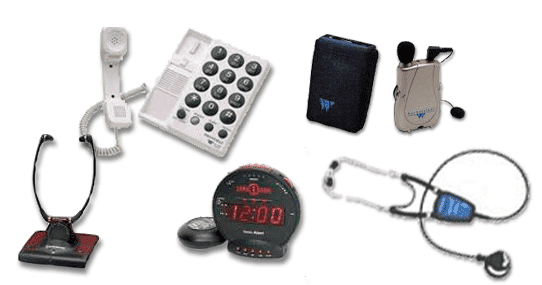Assistive listening devices - Assistive Listening Systems - Hearing Loss
Assistive listening systems generally refers to system-wide technology that's useful in public settings such as a theater, airport, church or lecture hall. The Americans with Disabilities Act, or ADA, mandates that most public places offer some type of assistive listening system.
There are three types of ALSs recognized by the ADA:
Hearing loops, also known as induction loops or audio frequency induction loop systems (AFILS), consist of a copper wire placed within a room, theater, or counter that is connected via a special loop “driver” to a public address or sound system. Sound is wirelessly transmitted via small changes in the magnetic field and is directed into the telecoil of hearing aids, cochlear implants, or telecoil receivers worn on the body, like a Neckloop.
FM or DM systems, or radio frequency assistive listening systems, transmit wireless, low-power FM frequency radio transmission from a sound system to FM receivers. Everyone using the system needs a receiver and either headphones or a Neckloop. For those who have telecoil-equipped hearing aids, Neckloops eliminate the need for headphones. These systems are widely used in schools to help children with hearing loss achieve their educational goals but they are also helpful for adults in many situations.
Infrared systems (IR) use invisible infrared light waves to transmit speech or music from a public address or sound system to an IR receiver. This technology is line-of-sight and can't be used in direct sunlight. Because IR signals are sent and received in a straight line, users are encouraged to sit as centrally as possible.
All assistive listening systems are required to be accessible for people with hearing aids, hearing aids with a telecoil, or hearing aids with no telecoil.
"If your hearing aid has this telecoil built in, connecting to a hearing loop is very easy," Sterkens says.
Of the three different public listening systems, hearing loops are preferred by most users, Sterkens says. "Many users like them so much they're working to get them installed all over the country."
Ask your hearing care provider for help
Hearing aid technology is impressive and can be a big help for people with hearing loss. However, if you have unique needs that aren’t addressed by your hearing aids or if you aren’t yet ready for hearing aids, assistive listening devices or systems can be the answer. But as you can see, there are many choices and options available—and these days, smartphones can even be considered a type of ALD! Your hearing care provider is your ally in this realm and can help you get set up with home ALDs or access public ALSs.
FAQs,
Personal assistive listening devices (ALDs)
They are commonly split into four different groups: amplified telephones, notification systems, personal amplifiers, and TV streamers.
What is an auditory trainer device?
All are designed to carry sound from the speaker (or other source) directly to the listener and to minimize or eliminate environmental noises. Some of these systems, such as auditory trainers, are designed for classroom or small group use. ... Models are available for use with or without hearing aids.
What is ALD hearing?
Assistive listening systems, also known as assistive listening devices (ALD), transmit sound directly to an individual who is wearing a sound receiver (hearing aid, headphone, neck loop etc.). ALDs reduce problems associated with background noise in one-on-one and group communication.







Post a Comment
Hello